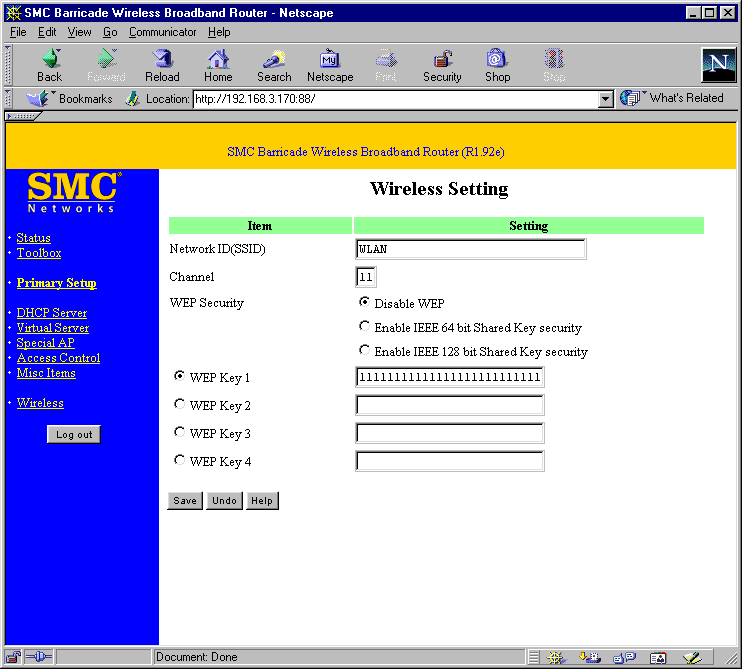Author: Tim Higgins
Review Date: 6/13/2001

Model: SMC7004AWBR
| Pros: | – Supports 64 & 128bit WEP – Built-in Windows/LPR print server |
| Cons : | – Doesn’t support bi-directional printer functions – 45% throughput decrease with WEP enabled – Still can’t attach external “booster” antennas |
| Review Updates1/31/02: Firmware jumps to 1.94a2 (for Part Number 750.5312 only). 1/4/02: NOTE: There are now two versions of the SMC 7004AWBR:
Check the bottom of your Barricade unit to see which you have, and download the appropriate firmware upgrade. 11/17/01 1.93s1 firmware is available. 6/14/01 1.93a1 firmware adds MAC address filtering and increases the number of virtual servers to 20. |
The Basics |
|
Introduction |
The SMC7004AWBR is a remodeled version of SMC’s Wireless Barricade that is replacing the WBR designated model. All the changes aren’t cosmetic, however, and the wireless portion takes some steps back in performance. |
What’s different? |
Since most of the AWBR’s functions were covered in the WBR and D-Link DI-713 reviews, I won’t repeat them here. See those reviews if you need more functional details. Instead, I’ll just focus on the what’s new. The AWBR is still sourced from AMIT and has a new circuit board that keeps the indicators on the front panel, but moves all connectors to the rear… a change that may be welcomed by many home users. A not-so-welcome change packaging change is the hump added toward the rear of the enclosure. This adds some needed ventilation holes (this baby still runs very warm to the touch!), but prevents you from stacking other boxes on top of it. SMC told me that there were supposed to be tall feet that would both raise the box off a table surface for bottom ventilation and allow stacking of boxes (you can see the mounting holes on the bottom of the box and indentations to receive the feet on the top cover of the enclosure), but there was a vendor mixup. It’s not clear whether the feet will eventually start appearing… The other cosmetic issue that I noticed is that the LEDs are difficult to see unless you are looking straight-on at the panel…especially the LAN indicators. As far as the electronics goes, the design uses the same components, except for a different radio card. The card is now fully connectorized (PC card bus and antennas) but still fully enclosed and not intended to be user-accessible. This new card adds 128bit WEP encryption to the WBR’s 40/64 bit, but my performance tests confirmed the WEP-enabled performance hit that some users have reported. The Wireless Performance section below has all the details. On a positive note, you’ll be able to enter four Hexadecimal WEP keys instead of one.
It’s also worth noting that the AWBR’s firmware raises the number of single port mappings (Virtual Servers) to 10 (20 via the 1.93a1 firmware update) and the number of triggered port range Special Applications to 8. These changes also apply if you upgrade the older WBR to the latest firmware. |
Router performance |
I ran the Qcheck suite to test routing performance: [Tests run with 1.92e firmware]
(Details of how we tested can be found here.) Comment: Routing Transfer rate is comparable to many present generation products and plenty fast for most broadband applications. UDP stream performance shows that the router is starting to strain to keep up with a 500kbps stream rate. | |||||||||||||||||
Wireless Performance |
I used an ORiNOCO Gold PC card as the wireless test partner, which I’ll be using from now on for all wireless testing. (More details of how I tested can be found here.) I decided to also run tests on the old WBR version to check out some rumored wireless performance differences. I upgraded the firmware on the older router to the current revision before testing. Here are the results:
Comments: Testing confirmed differences between the old and new versions. Throughput (Transfer Rate) on the newer AWBR takes a 45% WEP-enabled hit vs. an 11% hit on the older model. The retiring WBR also has better SNR (Signal to Noise Ratio) on the Condition 4 test than the newer model, although both turn in comparable throughput. | ||||||||||||||||||||||||||||||||||||||||||||||||||||||||||||||||||||||||
Summary |
Although the AWBR takes a step forward with the addition of 128bit WEP encryption, it also steps back with lower WEP-enabled throughput (although there’s no difference in degradation between 64 and 128 bit modes). But even with this performance difference, I still think that the Wireless Barricade is the best all-around wireless routing value out there, especially since the AWBR is on-line priced at about $235 vs. almost $300 for the older model. Definitely Recommended! |




